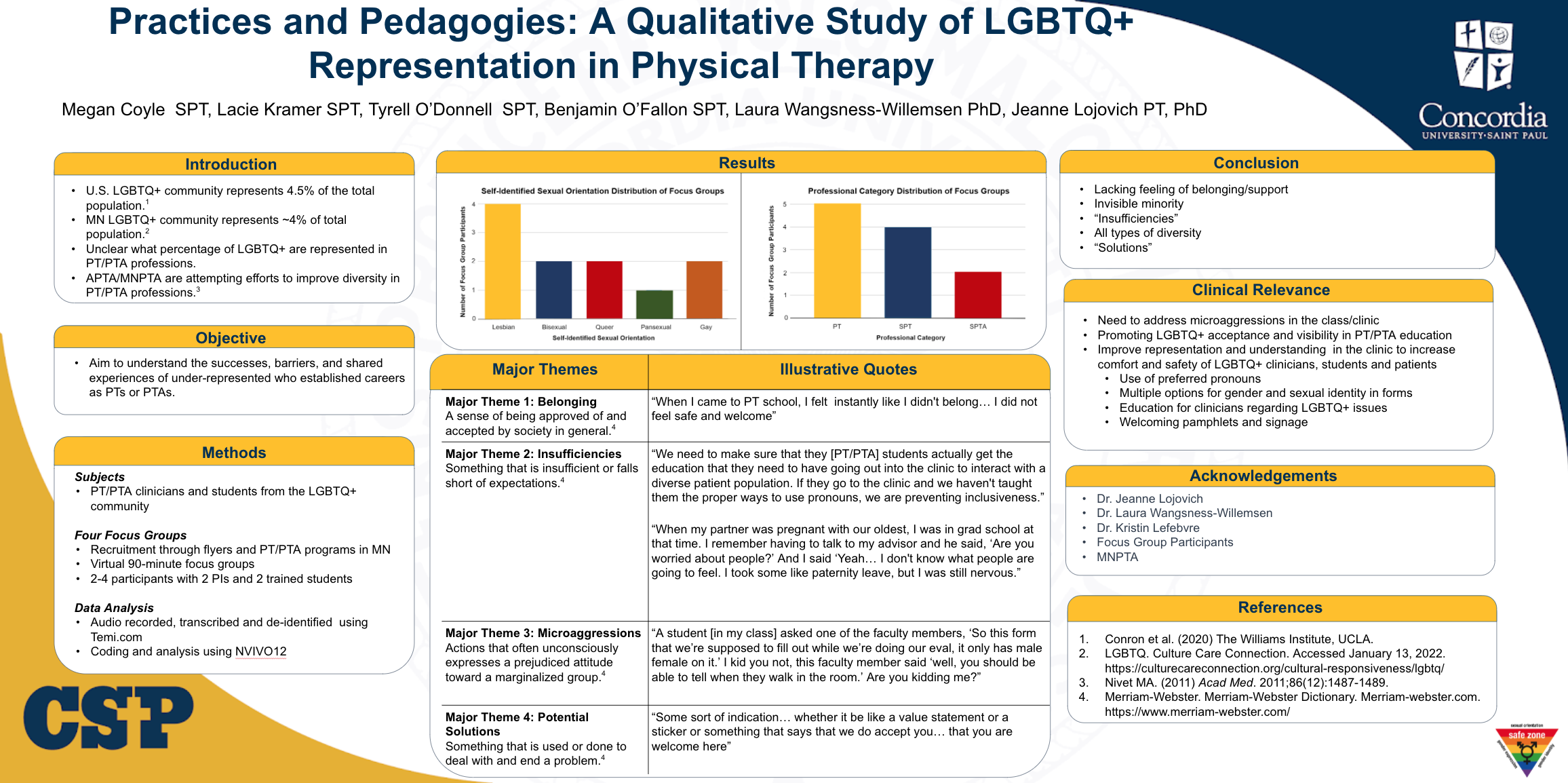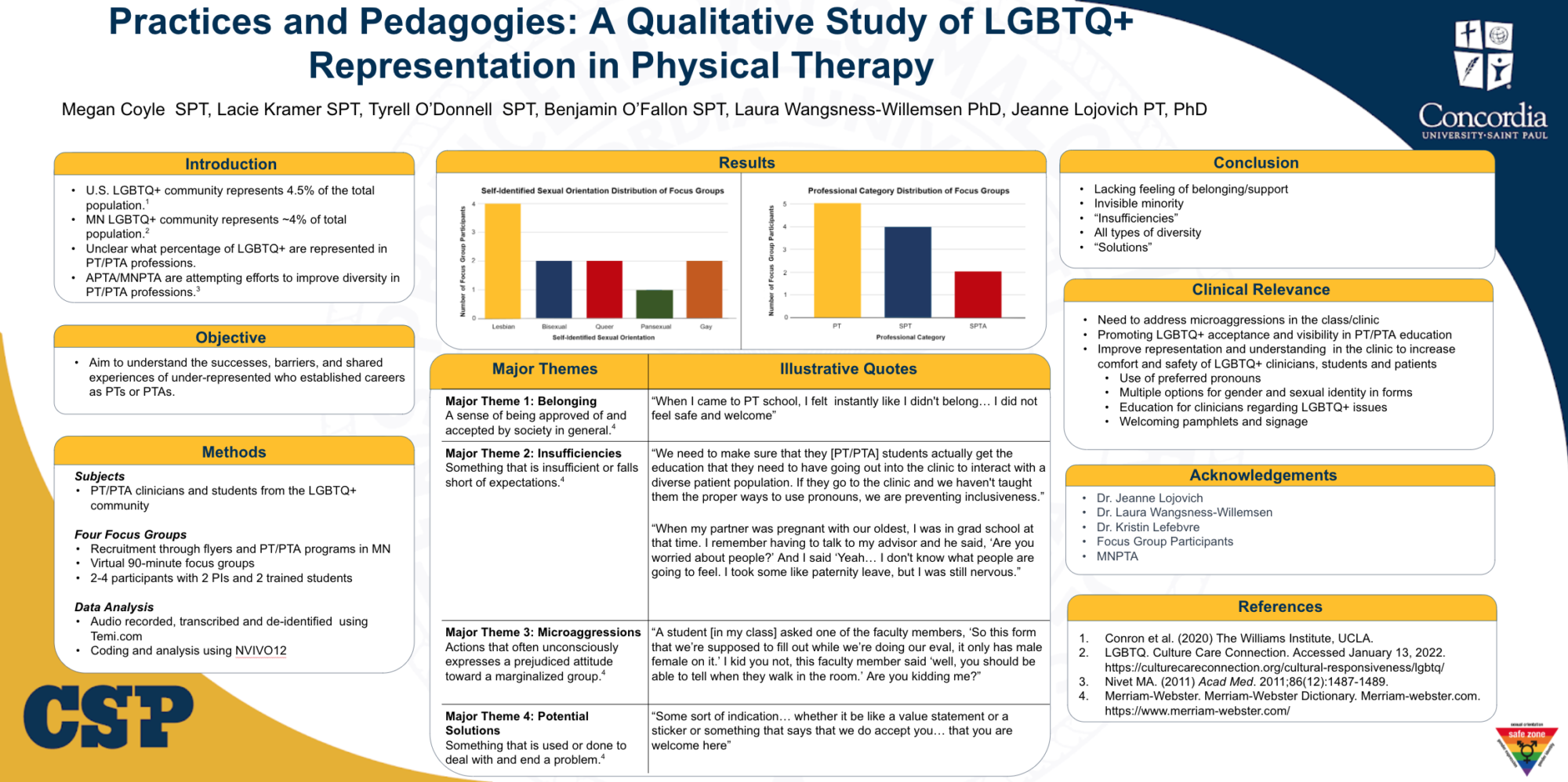Greetings Motion Community!
My name is Lacie Kramer and I am a student physical therapist from Concordia University St. Paul. I am having an amazing experience finishing my fourth clinical at Motion PT in St. Paul! I am passionate about diversity, inclusion, and consistency. This post is about the research I completed with my Capstone group throughout my time in Physical Therapy school.

Practices and Pedagogies: A Qualitative Study of LGBTQ+ Representation in Physical Therapy
Over the past few decades there has been a push for increasing diversity within healthcare services to better reflect the diversity in the United States. This includes but is not limited to increasing ethnic, gender, and sexual diversity. From a lens of social justice and equality, minority groups should logically have a representation in the healthcare workforce equal to their proportion of the US population.1 There is limited data on the actual percentage of LGBTQ+ PT/PTA students and clinicians. This is largely due to the fact that we don’t always ask individuals about their sexual orientation, gender identity or gender expression which makes them somewhat of an invisible minority. This qualitative study examined the barriers LGBTQ+ community members face when entering the PT/PTA profession. Conversations in our focus groups provided important insight to individuals’ real lived experiences. While our research did not reach saturation, we did identify major themes.
Why does this matter? While this idea has roots in social justice and equality, literature shows that increasing diversity in these professions will lead to better patient care.2,3
The first major theme centered around the feeling of belonging. Participants felt that they belonged during undergraduate education, but not during physical therapy (PT) school. One participant stated, “When I came to PT school, I felt instantly like I didn’t belong… I did not feel safe and welcome.”
We identified a second major theme of insufficiencies that contained multiple subthemes. Participants noted a lack of representation of LGBTQ+ members in the classroom and clinic and insufficient support for LGBTQ+ students and clinicians. Most of all, there is a deficit in classroom education regarding LGBTQ+ and a general lack of knowledge about the unique health and medical needs of these individuals. One participant made an important point by stating, “We have a lot of practice cases, that circle around race and identity and ethnicity, But always, what’s lacking is the LGBT part of it.”
Microaggressions in the classroom and clinic was the third theme. Microaggressions are defined as a subtle use of derogatory terms or negative attitudes that may be intentional or may be subconscious.1 For example, one of our participants stated, “When people ask me about what my husband does, I have to decide that day if I want to go there and have that conversation.”
What are potential solutions? We must address microaggressions in the class/clinic and promote LGBTQ+ acceptance and visibility in PT/PTA education. Improving representation and understanding in the classroom and clinic to increase comfort and safety of LGBTQ+ clinicians, students and patients is essential.
Here are some easy ways to create better inclusion today:
- Display a rainbow- a sign or flag
- State your pronouns when you introduce yourself
- Ask others what their pronouns are – it’s not offensive!
- Include fill in the blank options for pronouns and gender identity on forms
- Have non-gendered bathroom signs
- When in doubt use gender neutral words (ie: they/them)
- Hold Diversity, Equity, Inclusion staff meetings
- Get involved! Connect/participate/support/donate to LGBTQA+ groups, organizations, events, small businesses, etc:
There is much work to be done, as always. Recognizing these discrepancies allows for unlearning, learning, growing, and changing. Taking these steps gets us closer towards more inclusiveness and representation for the LGBTQ community within the physical therapy workplace, both for the professional and for the patient.
Be Kind & Stay Well!
Lacie Kramer, SPT, she/her
Acknowledgements:
- Dr. Jeanne Lojovich
- Dr. Laura Wangsness-Willemsen
- Dr. Kristin Lefebvre
- Megan Coyle
- Tyrell O’Donnell
- Benjamin O’Fallon
- Focus Group Participants
- MNPTA
References:
- Nivet MA. Commentary: Diversity 3.0: a necessary systems upgrade. Acad Med. 2011;86(12):1487-1489. doi:10.1097/ACM.0b013e3182351f79
- Institute of Medicine Committee on Institutional and Policy-Level Strategies for Increasing the Diversity of the U.S. Healthcare Workforce. In the Nation’s Compelling Interest: Ensuring Diversity in the Health-Care Workforce. Smedley BD, Stith Butler A, Bristow LR, eds. Washington, DC: National Academies Press; 2004. http://www.ncbi.nlm.nih.gov/books/NBK216009/. Accessed December 19, 2014.
- Cohen JJ, Gabriel BA, Terrell C. The case for diversity in the healthcare workforce. Health Aff (Millwood). 2002;21:90–102.




